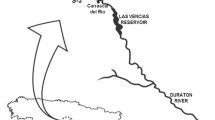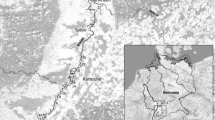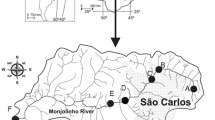Abstract
The tolerance of the invasive amphipod Dikerogammarus villosus to fluoride (F−) toxicity was examined via laboratory experiments. 96-h LC50 and 240-h NOEC values were estimated to be 5.8 and 0.95 mg F−/L, respectively. Average whole-body fluoride content in control amphipods was 27.6 μg F−/g dry weight, whereas in exposed amphipods it ranged from 3,637 to 16,994 μg F−/g dry weight. All these results indicate that D. villosus is a very sensitive species to fluoride toxicity. Overall it is concluded that the potential risk of invasion for D. villosus in either natural or polluted freshwater ecosystems, exhibiting relatively high fluoride levels (at least ten-fold higher than the average freshwater background level of 0.15 mg F−/L), must be low.
Similar content being viewed by others
Explore related subjects
Discover the latest articles, news and stories from top researchers in related subjects.Avoid common mistakes on your manuscript.
Fluoride (F−) concentrations in unpolluted fresh waters generally range from 0.01 to 0.3 mg F−/L whilst in unpolluted seawaters generally range from 1.2 to 1.5 mg F−/L (World Health Organization 2002; Camargo 2003). Nevertheless, fluoride must be considered as a serious pollutant since its concentration in many aquatic ecosystems is significantly increasing as a consequence of human activities. Aluminum and zinc smelters have been reported to increase in more than 5 times the natural background level of 0.3 mg F−/L in some fresh waters of Norway and Canada (World Health Organization 2002; Camargo 2003). Other activities such as phosphate fertilizer plants, plants producing fluoride chemicals (e.g., hydrogen fluoride, sodium fluoride, sulphur hexafluoride), plants manufacturing brick, ceramics and glass, and the use of fluoride containing pesticides can cause significant increases (more than 100 times the natural background levels of 0.1–0.2 mg F−/L) in the fluoride concentration of surface waters (World Health Organization 2002; Camargo 2003). Discharges of fluoridated municipal waters can also cause significant increases (about 5 times the natural background levels of 0.2–0.3 mg F−/L) in the fluoride concentration of recipient rivers (World Health Organization 2002; Camargo 2003).
On the other hand, Dikerogammarus villosus (Sowinsky, 1894) (Gammaridae, Amphipoda, Crustacea) is one of the most successful macroinvertebrate invaders of aquatic ecosystems in Europe. Its native distribution includes the Black Sea Basin and the Caspian Sea Basin, but currently it can be found in many European freshwater ecosystems (Devin et al. 2001; Dick et al. 2002; Casellato et al. 2006, 2007). Furthermore, D. villosus has become very abundant in some European lakes and rivers, being the primary cause for alarming extinctions of native gammarids as well as for declines in populations of other aquatic animals (Devin et al. 2001; Dick et al. 2002; Casellato et al. 2006, 2007).
The main goal of this study was to examine the tolerance of this invasive gammarid species to fluoride toxicity in order to evaluate its potential risk of invasion in freshwater ecosystems with relatively high fluoride levels (at least ten-fold higher than the average freshwater background level of 0.15 mg F−/L). In addition, a secondary goal was to examine the fluoride content in gammarids after their short-term exposure to fluoride ions. Because the toxicity of pollutants depends greatly on their uptake and retention by organisms (Walker et al. 2005), we expected that, in the case of a high sensitivity of D. villosus to fluoride ions, the fluoride content in gammarids after their short-term exposure should be significantly increased.
Materials and Methods
Water and gammarids for laboratory experiments were obtained from Lake Garda, a deep subalpine lake located in Northern Italy. Animals were transported to the laboratory using plastic containers. No mortality occurred during transportation. Gammarids were acclimatized to laboratory conditions for 2 weeks prior to toxicity bioassays, being fed with commercial fish food (TetraMin in flakes). No mortality occurred during acclimatization. Gammarids used for experiments had an average size of 14.5 ± 2.7 mm in length.
Two different toxicity bioassays were conducted in the Department of Biology at the University of Padova (Padova, Italy), using small glass aquaria (1 L) with air pumps and air stones as experimental units. In the first bioassay (without water renewal and animal feeding), gammarids were exposed in triplicate to a range of higher fluoride concentrations for 4 days. Nominal fluoride concentrations were 5, 10, 20, 40 and 80 mg F−/L, though actual fluoride concentrations ranged from 4.2 to 72.8 mg F−/L. Five adult gammarids (males and females indistinctly) were used per fluoride concentration and replicate. In the second bioassay (with water renewal and animal feeding), gammarids were exposed in duplicate to a range of lower fluoride concentrations for 10 days. Nominal fluoride concentrations were 0.5, 1 and 2 mg F−/L, though actual fluoride concentrations ranged from 0.46 to 1.9 mg F−/L. Eight adult gammarids (males and females indistinctly) were used per fluoride test concentration and replicate. Animals were fed every 2–3 days using commercial fish food (TetraMin in flakes), and test water was renewed every 3–4 days. Fluoride test concentrations were made from sodium fluoride (minimum 99.5% NaF, Merck, Germany), and analyzed according to the standardized colorimetric method (American Public Health Association 1998). Fluoride levels in control aquaria during both short-term toxicity bioassays were below 0.20 mg F−/L.
Toxicity bioassays were conducted in a climate chamber at controlled temperature of 17°C. Average values of other water quality conditions were 8.0 ± 0.1 for pH, 8.4 ± 0.2 mg O2/L for dissolved oxygen, and 106 ± 14 mg CaCO3/L for total hardness. Dissolved oxygen and pH values were recorded using standard oxygen and pH meters, and total hardness was determined according to the standardized colorimetric method (American Public Health Association 1998). Gammarid mortality was recorded daily, dead animals being removed and kept in formaldehyde at 4%. At the end of laboratory experiments, surviving gammarids were also removed and kept in formaldehyde at 4%. All animal samples were taken to the Department of Ecology at the University of Alcalá (Spain), where gammarids were measured in size and their whole-body fluoride content determined. Fluoride content, expressed as μg F−/g dry weight, was analyzed following the fusion alkali method and using a fluoride-ion selective electrode (McQuaker and Gurney 1977; Malde et al. 2001).
LC50 values, and their respective 95% confidence limits, were calculated with mortality data, exposure times, and actual fluoride concentrations from the first short-term toxicity bioassay, using the multifactor probit analysis (MPA) software (US Environmental Protection Agency 1991). The MPA methodology solves the concentration–time-response equation simultaneously via the iterative reweighed least squares technique (multiple linear regression). The dependent variable is the probit of the proportion responding to each concentration, and the independent variables are exposure time and toxicant concentration. LC0.01 values (as safe concentrations), and their respective 95% confidence limits, were also estimated using the MPA software. Besides, the no-observed-effect concentration (NOEC) and the lowest-observed-effect concentration (LOEC) were determined in accordance with observed results from the second short-term toxicity bioassay. Statistical differences among fluoride test treatments, regarding whole-body fluoride content in each treatment, were examined using the SPSS software (version 15.0). Given the lack of normality and homoscedasticity of variances, a non-parametric Kruskal–Wallis test was performed to determine statistical differences, and post-hoc Mann–Whitney tests were used for pair comparisons. Significant differences were accepted at p < 0.0083, since we used a Bonferroni correction to control Type I error rate.
Results and Discussion
Gammarid mortality increased with increasing both fluoride concentration and exposure time. 100% mortality occurred within the first 24 h at the two highest nominal concentrations (40 and 80 mg F−/L), whereas only an average mortality of 13.3% occurred after 96 h of exposure at the lowest nominal concentration (5 mg F−/L). No mortality occurred in control aquaria. Estimated LC50 and LC0.01 values for the first toxicity bioassay, as well as observed LOEC and NOEC values for the second toxicity bioassay, are presented in Table 1. LC50 and LC0.01 values exhibited a tendency to decrease with increasing exposure times. Furthermore, it should be evident that the estimated 240-h LC0.01 value and its respective 95% confidence limits fall relatively well within the range of observed 240-h LOEC and NOEC values.
A comparison of these obtained toxicity data with previous toxicity data for other sensitive aquatic animals shows that D. villosus is a relatively very sensitive species to fluoride toxicity. For example, the 48-h LC50 value for the cladoceran Daphnia magna ranges between 98 and 304 mg F−/L (Dave 1984; Fieser et al. 1986); 96-h LC50 values for the fishes Pimephales promelas and Gasterosteus aculeatus range between 315 and 340 mg F−/L (Smith et al. 1985); 96-h LC50 values for the salmonids Oncorhynchus mykiss and Salmo trutta range between 51 and 200 mg F−/L (Pimentel and Bulkley 1983; Smith et al. 1985; Camargo 1991); 96-h LC50 values for the hydropsychids Hydropsyche bronta, H. bulbifera and H. exocellata range between 17.0 and 26.5 mg F−/L (Camargo and Tarazona 1990; Camargo et al. 1992); and the 96-h LC50 value for the amphipod Hyalella azteca was estimated to be 14.6 mg F−/L (Metcalfe-Smith et al. 2003).
It has been reported that aquatic animals living in soft waters with low ionic content may be more adversely affected by fluoride pollution than those living in hard or seawaters, since fluoride bioavailability may be significantly reduced with increasing calcium water content (Pimentel and Bulkley 1983; Smith et al. 1985; Camargo 2003). However, despite toxicity bioassays with D. villosus were conducted in hard waters (106 ± 14 mg CaCO3/L for total hardness), estimated LC50 and LC0.01 values, as well as LOEC and NOEC values, were relatively low (Table 1). Furthermore, as far as we know, D. villosus would be one of the most sensitive aquatic animal species to fluoride toxicity.
Average values of whole-body fluoride content in D. villosus, at different water fluoride concentrations and exposure times, are presented in Table 2. As expected, since the toxicity of pollutants depends greatly on their uptake and retention by organisms (Walker et al. 2005), whole-body fluoride content in gammarids after their short-term exposure to fluoride ions significantly increased with both water fluoride concentration and exposure time (Table 2).
Fluoride ions are mainly taken up directly from water by aquatic animals, and far less from food (reviewed in Camargo 2003). This uptake is a function of fluoride concentration in the aquatic medium, exposure time, and water temperature. Part of this fluoride may be eliminated via excretory systems, but it will mainly be bioaccumulated (Kessabi 1984; Camargo 2003). The results of this research concur with those previous findings, since fluoride content in D. villosus increased with both water fluoride concentration and exposure time. High levels of fluoride (up to 16,994 μg F−/g dry weight) were found in gammarids exposed to different fluoride concentrations at different periods (Table 2), whereas the mean fluoride content in control individuals was 27.6 μg F−/g dry weight. Moreover, this amphipod species seemed to bioaccumulate fluoride quite fast. Within the first 24 h, dead amphipods, exposed to 10, 20, 40 and 80 mg F−/L, exhibited mean whole-body fluoride levels of 5,007, 5,965, 8,761, and 13,955 μg F−/g dry weight, respectively. And at an exposure concentration of 10 mg F−/L, gammarids were able to survive for 72 h, reaching the highest whole-body fluoride content found in this laboratory study, 16,994 ± 503 μg F−/g dry weight (Table 2). We believe that the great capacity of D. villosus to take up and retain fluoride during short-term exposures might be a major cause of its great sensitivity to fluoride toxicity. However, because as far as we know, no study has been previously conducted to examine fluoride bioaccumulation in freshwater crustaceans at different times and exposures, it is difficult to evaluate properly the capacity of D. villosus to take up and retain fluoride regarding other related aquatic animals.
Owing to several human activities, fluoride concentrations in many aquatic ecosystems are currently increasing worldwide (World Health Organization 2002; Camargo 2003). In some cases, anthropogenic sources can cause significant increases (more than 100 times the natural background levels of 0.1–0.2 mg F−/L) in the fluoride concentration of surface waters (World Health Organization 2002; Camargo 2003). On the other hand, naturally elevated levels of fluoride ions (> 10 mg F−/L) in surface waters may be a consequence of geothermal or volcanic activity, or a result of the dissolution of fluorine containing minerals (World Health Organization 2002; Camargo 2003). Consequently, because of its great sensitivity to fluoride toxicity (Tables 1 and 2), we can conclude that the potential risk of invasion for D. villosus in either natural or polluted freshwater ecosystems, exhibiting relatively high fluoride levels (at least ten-fold higher than the average freshwater background level of 0.15 mg F−/L), must be low. Nonetheless, anthropogenic increases in the fluoride concentration of fresh waters may never be considered as a feasible procedure to prevent the spread of unwanted species such as D. villosus, given the lethal effect that those elevated fluoride levels could have on sensitive native species.
References
American Public Health Association (1998) Standard methods for the examination of water and wastewater, 200th edn. APHA-AWWA-WPCF, Washington, DC
Camargo JA (1991) Ecotoxicological analysis of the influence of an industrial effluent on fish populations in a regulated stream. Aquacult Fish Manag 22:509–518
Camargo JA (2003) Fluoride toxicity to aquatic organisms: a review. Chemosphere 50:251–264
Camargo JA, Tarazona JV (1990) Acute toxicity to freshwater macroinvertebrates of fluoride ion (F−) in soft water. Bull Environ Contam Toxicol 45:883–887
Camargo JA, Ward JV, Martin KL (1992) The relative sensitivity of competing hydropsychid species to fluoride toxicity in the Cache La Poudre River (Colorado). Arch Environ Contam Toxicol 22:107–113
Casellato S, La Piana G, Latella L, Ruffo S (2006) Dikerogammarus villosus (Sowinsky, 1894) (Crustacea, Amphipoda, Gammaridae) for the first time in Italy. Ital J Zool 73:97–104
Casellato S, Visentin A, La Piana G (2007) The predatory impact of Dikerogammarus villosus on fish. In: Gherardi F (ed) Biological invaders in inland waters: profiles, distribution and threats. Springer, Berlin, pp 495–506
Dave G (1984) Effect of fluoride on growth, reproduction and survival of Daphnia magna. Comp Biochem Physiol 78c:425–431
Devin S, Beisel JN, Bachmann V, Moreteau JC (2001) Dikerogammarus villosus (Amphipoda: Gammaridae): another invasive species newly established in the Moselle river and French hydrosystems. Ann Limnol 37:21–27
Dick JTA, Platvoet D, Kelly DW (2002) Predatory impact of the freshwater invader Dikerogammarus villosus (Crustacea: Amphipoda). Can J Fish Aquat Sci 59:1078–1084
Fieser AH, Sykora JL, Kostalos MS, Wu YC, Weyel DW (1986) Effect of fluorides on survival and reproduction of Dapnia magna. J Water Pollut Control Fed 58:82–86
Kessabi M (1984) Métabolisme et biochimie toxicologique du fluor: une revue. Revue Méd Vét 135:497–510
Malde MJ, Bjorvatn K, Julshamn K (2001) Determination of fluoride in food by the use of alkali fusion and fluoride ion-selective electrode. Food Chem 73:373–379
McQuaker NR, Gurney M (1977) Determination of total fluoride in soil and vegetation using an alkali fusion-selective ion electrode technique. Anal Chem 49:53–56
Metcalfe-Smith JL, Holtze KE, Sirota GR, Reid JJ, de Solla SR (2003) Toxicity of aqueous and sediment-associated fluoride to freshwater organisms. Environ Toxicol Chem 22:161–166
Pimentel R, Bulkley RV (1983) Influence of water hardness on fluoride toxicity to rainbow trout. Environ Toxocol Cham 2:381–386
Smith LR, Holsen TM, Ibay NC, Block RM, Leon AB (1985) Studies on the acute toxicity of fluoride ion to stickleback, fathead minnow and rainbow trout. Chemosphere 14:1383–1389
US Environmental Protection Agency (1991) Multifactor probit analysis. US EPA 600/X-91-101, Washington, DC
Walker CH, Hopkin SP, Sibly RM, Peakall DB (2005) Principles of ecotoxicology, 3rd edn. CRC Press, Boca Raton (FL)
World Health Organization (2002) Environmental health criteria 227: fluorides. WHO, Geneva
Acknowledgments
We thank the Spanish Ministry of Science and Innovation (project CGL2006-06804/BOS) for the funds to carry out this research. We also want to thank the Spanish Ministry of Education and the Italian Ministry of Public Education, as well as the University of Alcalá and the University of Padova, for providing additional funds and logistical support. Cristina Gonzalo is currently supported by a doctoral contract from the Spanish Ministry of Education. Lastly, we are grateful to an anonymous reviewer for valuable comments and suggestions.
Author information
Authors and Affiliations
Corresponding author
Rights and permissions
About this article
Cite this article
Gonzalo, C., Camargo, J.A., Masiero, L. et al. Fluoride Toxicity and Bioaccumulation in the Invasive Amphipod Dikerogammarus villosus (Sowinsky, 1894): a Laboratory Study. Bull Environ Contam Toxicol 85, 472–475 (2010). https://doi.org/10.1007/s00128-010-0132-8
Received:
Accepted:
Published:
Issue Date:
DOI: https://doi.org/10.1007/s00128-010-0132-8




